Enhancing Wear Resistance of A390 Aluminum Alloy: A Comprehensive Evaluation of Thermal Sprayed WC, CrC, and Al2O3 Coatings
Abstract
:1. Introduction
2. Materials and Methods
3. Results
4. Conclusions
Author Contributions
Funding
Institutional Review Board Statement
Informed Consent Statement
Data Availability Statement
Conflicts of Interest
References
- Bang, J.; Byon, E.; Lee, E. Effects of Na2B4O7·10H2O on microstructure and mechanical properties of AlSi7Mg0.3 and AlSi10MnMgAlSi10MnMg alloys. J. Adv. Mar. Eng. Technol. 2021, 45, 363–370. [Google Scholar] [CrossRef]
- Moon, G.; Seo, H.-I.; Seo, D.-H.; Lee, E. Application of the Convolutional Neural Network for Classification of the Aluminum Alloys Based on Their Microstructural Characteristics. JOM 2023, 75, 4858–4867. [Google Scholar] [CrossRef]
- Dash, S.S.; Chen, D. A Review on Processing–Microstructure–Property Relationships of Al-Si Alloys: Recent Advances in Deformation Behavior. Metals 2023, 13, 609. [Google Scholar] [CrossRef]
- Kang, H.-J.; Park, J.-Y.; Choi, Y.-S.; Cho, D.-H. Influence of the Solution and Artificial Aging Treatments on the Microstructure and Mechanical Properties of Die-Cast Al–Si–Mg Alloys. Metals 2022, 12, 71. [Google Scholar] [CrossRef]
- Bararpour, S.M.; Jamshidi Aval, H.; Jamaati, R.; Javidani, M. Effect of initial heat treatment of A390 alloy on microstructure and tribological behavior of friction surfaced coating. Surf. Coat. Technol. 2024, 478, 130359. [Google Scholar] [CrossRef]
- Lee, J.Y.; Lee, E. Crystallographic orientation-dependent corrosion behavior of aluminum under residual stress. Mater. Charact. 2023, 205, 113310. [Google Scholar] [CrossRef]
- Jonda, E.; Łatka, L.; Tomiczek, A.; Godzierz, M.; Pakieła, W.; Nuckowski, P. Microstructure Investigation of WC-Based Coatings Prepared by HVOF onto AZ31 Substrate. Materials 2022, 15, 40. [Google Scholar] [CrossRef]
- Trebuňová, M.; Kottfer, D.; Kyziol, K.; Kaňuchová, M.; Medveď, D.; Džunda, R.; Kianicová, M.; Rusinko, L.; Breznická, A.; Csatáryová, M. The WC and CrC Coatings Deposited from Carbonyls Using PE CVD Method—Structure and Properties. Materials 2023, 16, 5044. [Google Scholar] [CrossRef] [PubMed]
- Bang, J.; Kwon, H.; Byon, E.; Lee, E. Understanding of microstructures and mechanical properties of thermal sprayed Ni-based coatings with Al and Mo addition. J. Adv. Mar. Eng. Technol. 2022, 46, 342–347. [Google Scholar] [CrossRef]
- Amin, S.; Panchal, H. A review on thermal spray coating processes. Transfer 2016, 2, 556–563. [Google Scholar]
- Li, H.; Liu, P.; Huang, K.; Sun, R. Research and Application of High-Velocity Oxygen Fuel Coatings. Coatings 2022, 12, 828. [Google Scholar] [CrossRef]
- Turunen, E.; Suhonen, T.; Varis, T.; Hannula, S.-P. Optimization and Characterization of High Velocity Oxy-fuel Sprayed Coatings: Techniques, Materials, and Applications. Coatings 2011, 1, 17–52. [Google Scholar] [CrossRef]
- Goral, M.; Kubaszek, T.; Grabon, W.A.; Grochalski, K.; Drajewicz, M. The Concept of WC-CrC-Ni Plasma-Sprayed Coating with the Addition of YSZ Nanopowder for Cylinder Liner Applications. Materials 2023, 16, 1199. [Google Scholar] [CrossRef] [PubMed]
- Qin, J.; Chen, Y.; Liu, J.; Wang, Y. Revealing the role of sealing treatment on the electrochemical corrosion properties of HVOF-sprayed WC-20Cr3C2-7Ni/MWCNTs coating. J. Mater. Res. Technol. 2023, 25, 2486–2497. [Google Scholar] [CrossRef]
- Mauer, G.; Rauwald, K.-H.; Sohn, Y.J.; Vaßen, R. The Potential of High-Velocity Air-Fuel Spraying (HVAF) to Manufacture Bond Coats for Thermal Barrier Coating Systems. J. Therm. Spray Technol. 2024, 33, 746–755. [Google Scholar] [CrossRef]
- Rahman, M.; Ahmed, S.; Lee, K.; Kim, J. Surface preparation of aluminum by atmospheric-pressure plasma jet for suspension plasma sprayed ceramic coatings. Surf. Coat. Technol. 2024, 476, 130175. [Google Scholar] [CrossRef]
- Hu, J.; Zhang, C.; Wang, X.; Meng, X.; Dou, C.; Yu, H.; Wang, C.; Xue, J.; Qiao, Z.; Jiang, T. Improving the Wear Resistance Properties of 7A04 Aluminum Alloy with Three Surface Modification Coatings. Coatings 2024, 14, 476. [Google Scholar] [CrossRef]
- Hong, S.; Wang, Z.; Zhou, H.; Liu, X. Influences of sand concentration and flow velocity on hydro-abrasive erosion behaviors of HVOF sprayed Cr3C2-NiCr and WC-Cr3C2-Ni coatings. J. Mater. Res. Technol. 2022, 21, 1507–1518. [Google Scholar] [CrossRef]
- Pan, X.; Zhou, L.; Hu, D.; He, W.; Liu, P.; Yu, Z.; Liang, X. Superior wear resistance in cast aluminum alloy via femtosecond laser induced periodic surface structures and surface hardening layer. Appl. Surf. Sci 2023, 636, 157866. [Google Scholar] [CrossRef]
- Zhao, P.; Shi, Z.; Wang, X.; Li, Y.; Cao, Z.; Zhao, M.; Liang, J. A Review of the Laser Cladding of Metal-Based Alloys, Ceramic-Reinforced Composites, Amorphous Alloys, and High-Entropy Alloys on Aluminum Alloys. Lubricants 2023, 11, 482. [Google Scholar] [CrossRef]
- Rúa Ramirez, E.; Silvello, A.; Torres Diaz, E.; Vaz, R.F.; Garcia Cano, I. A Comparative Study of the Life Cycle Inventory of Thermally Sprayed WC-12Co Coatings. Metals 2014, 4, 431. [Google Scholar] [CrossRef]
- ASTM C633-13; Standard Test Method for Adhesion or Cohesion Strength of Thermal Spray Coatings. ASTM International: West Conshohocken, PA, USA, 2021.
- ASTM E384-22; Standard Test Method for Microindentation Hardness of Materials. ASTM International: West Conshohocken, PA, USA, 2022.
- ASTM G99-17; Standard Test Method for Wear Testing with a Pin-on-Disk Apparatus. ASTM International: West Conshohocken, PA, USA, 2023.
- Gao, P.-H.; Chen, B.-Y.; Wang, W.; Jia, H.; Li, J.-P.; Yang, Z.; Guo, Y.-C. Simultaneous increase of friction coefficient and wear resistance through HVOF sprayed WC-(nano WC-Co). Surf. Coat. Technol. 2019, 363, 379–389. [Google Scholar] [CrossRef]
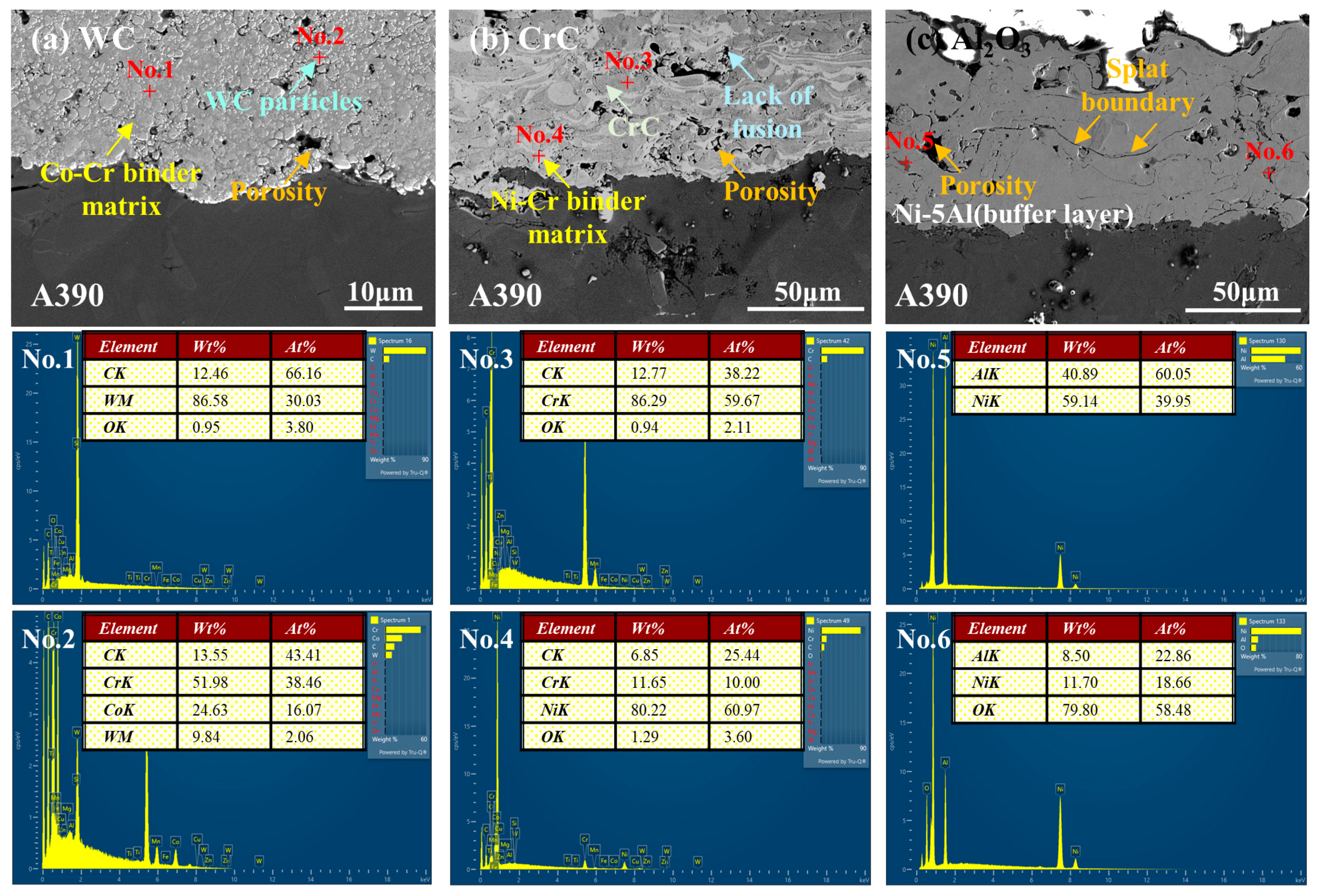
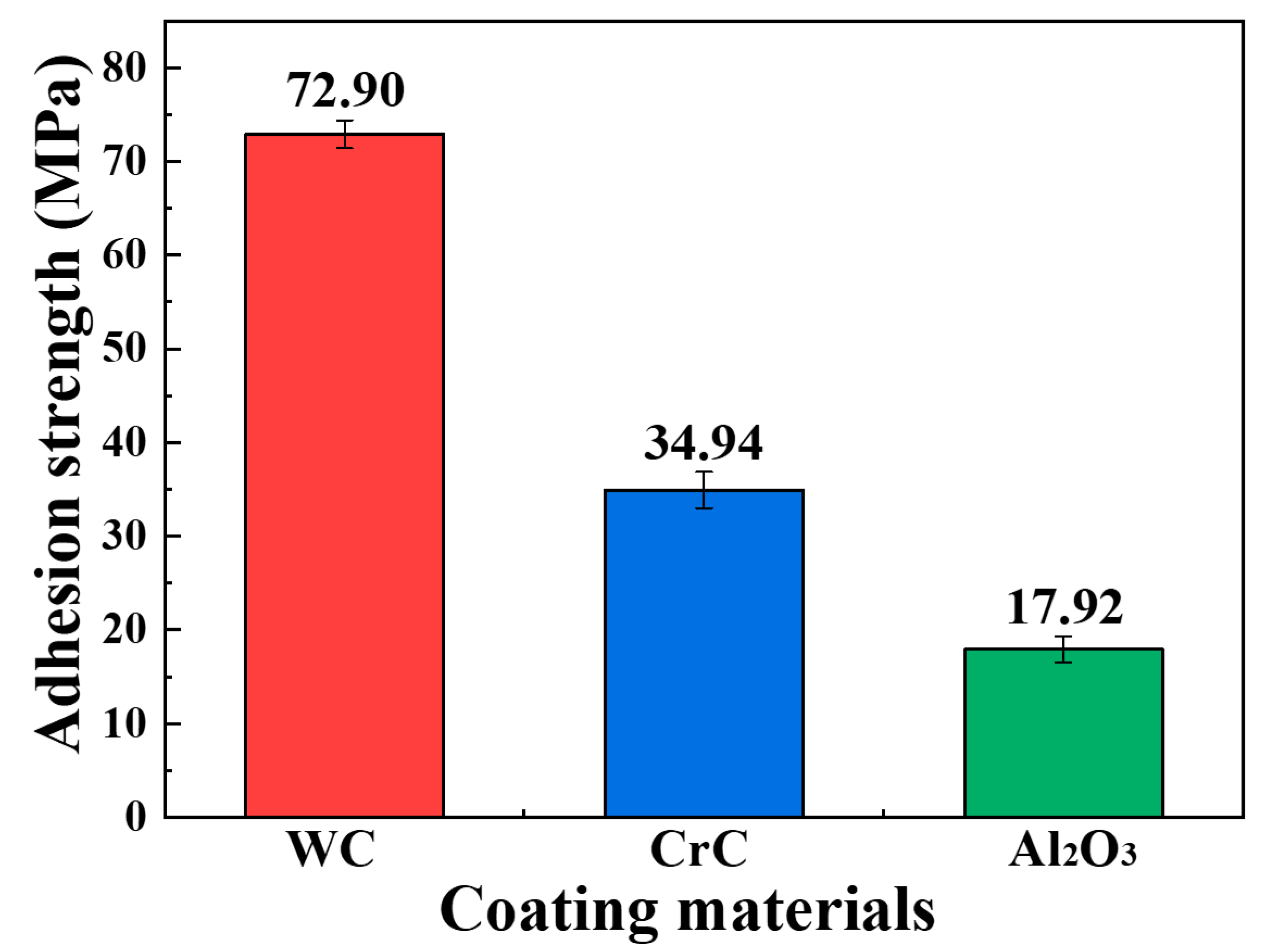
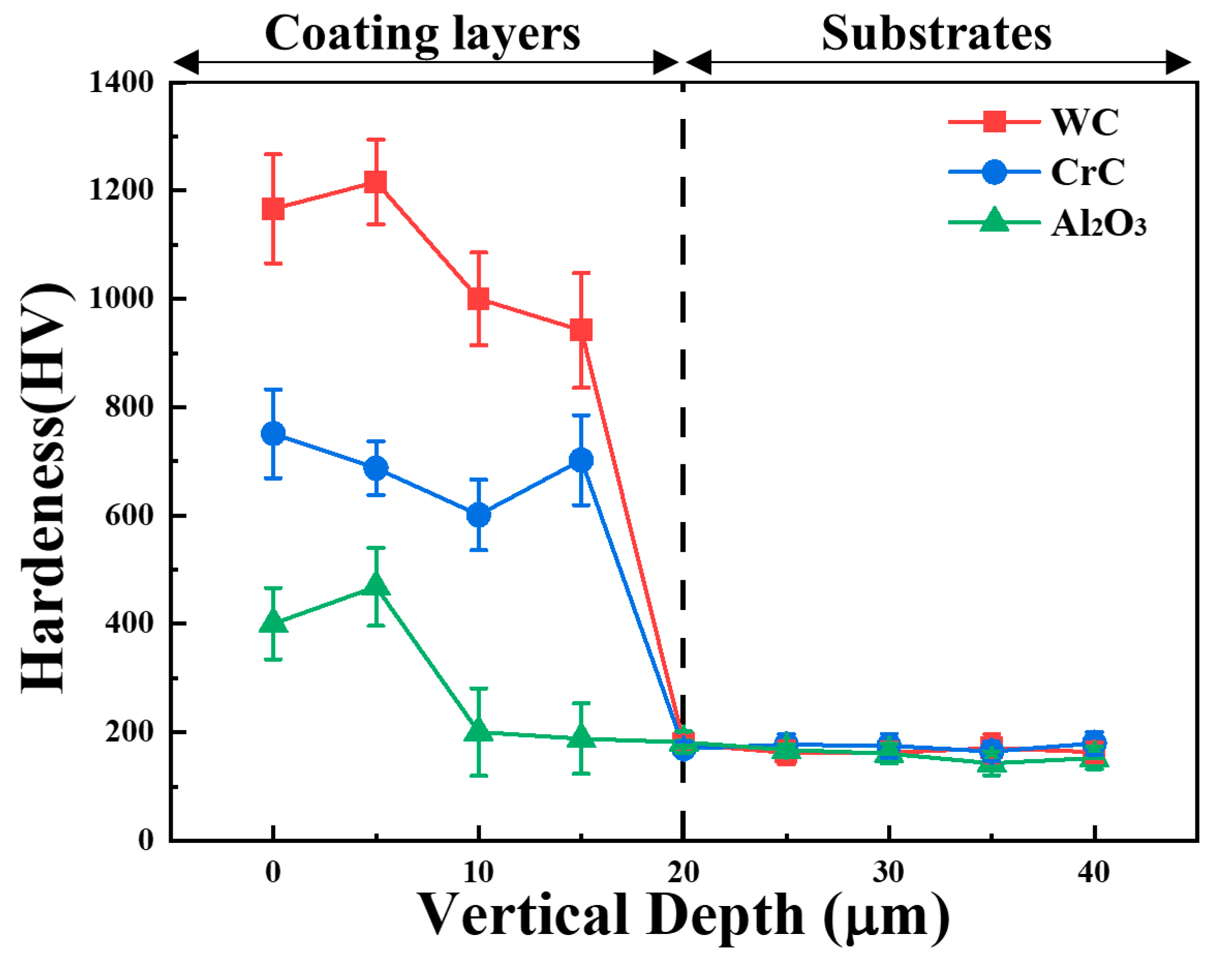
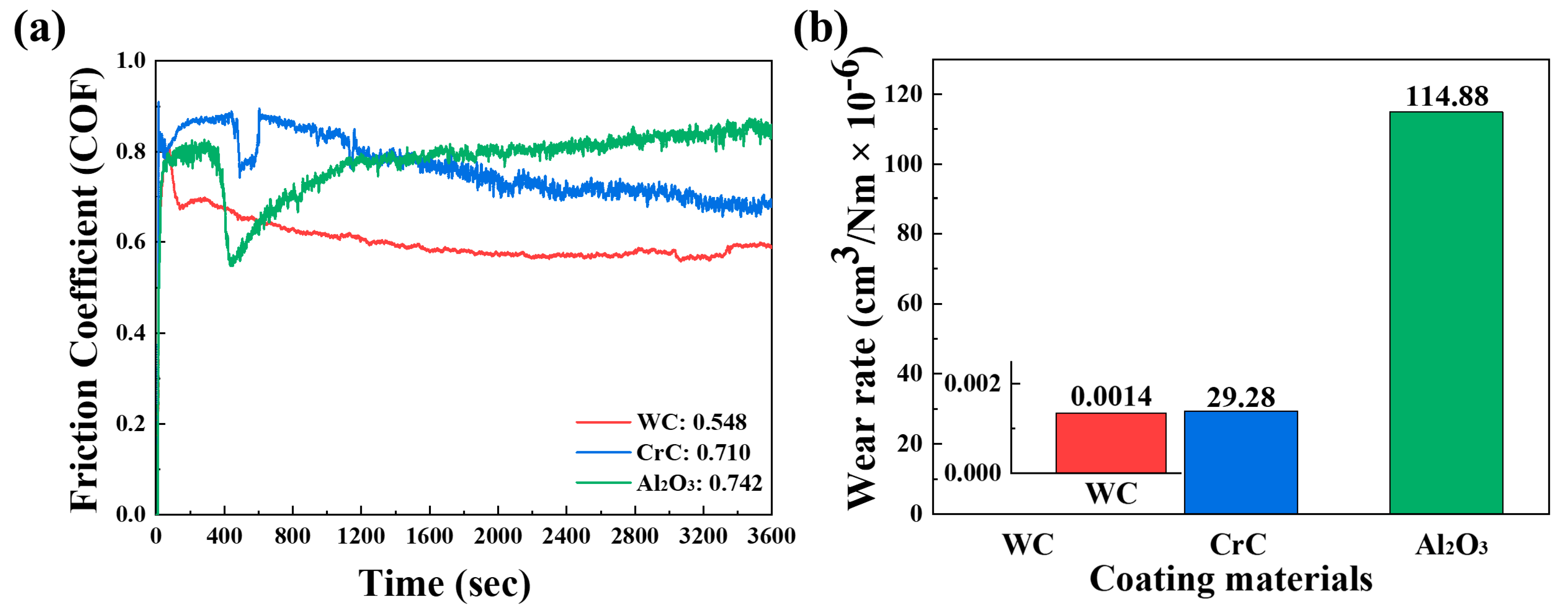
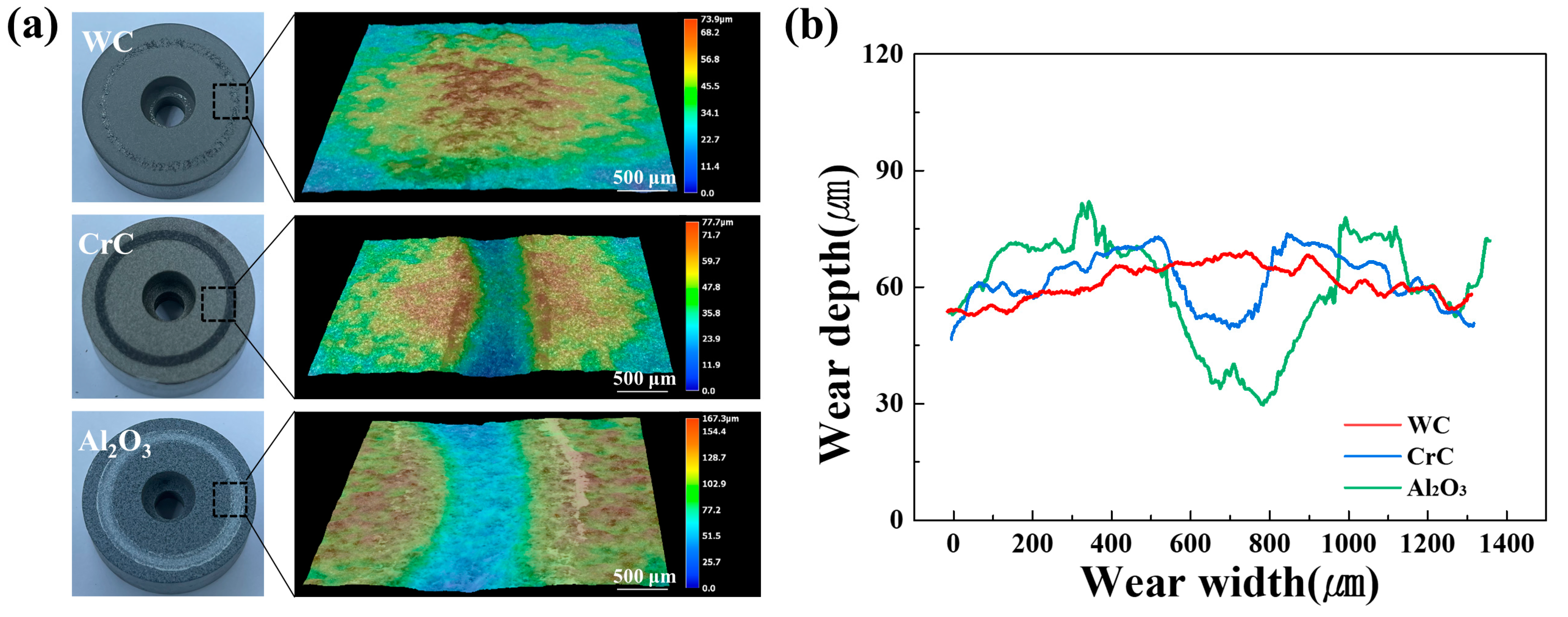

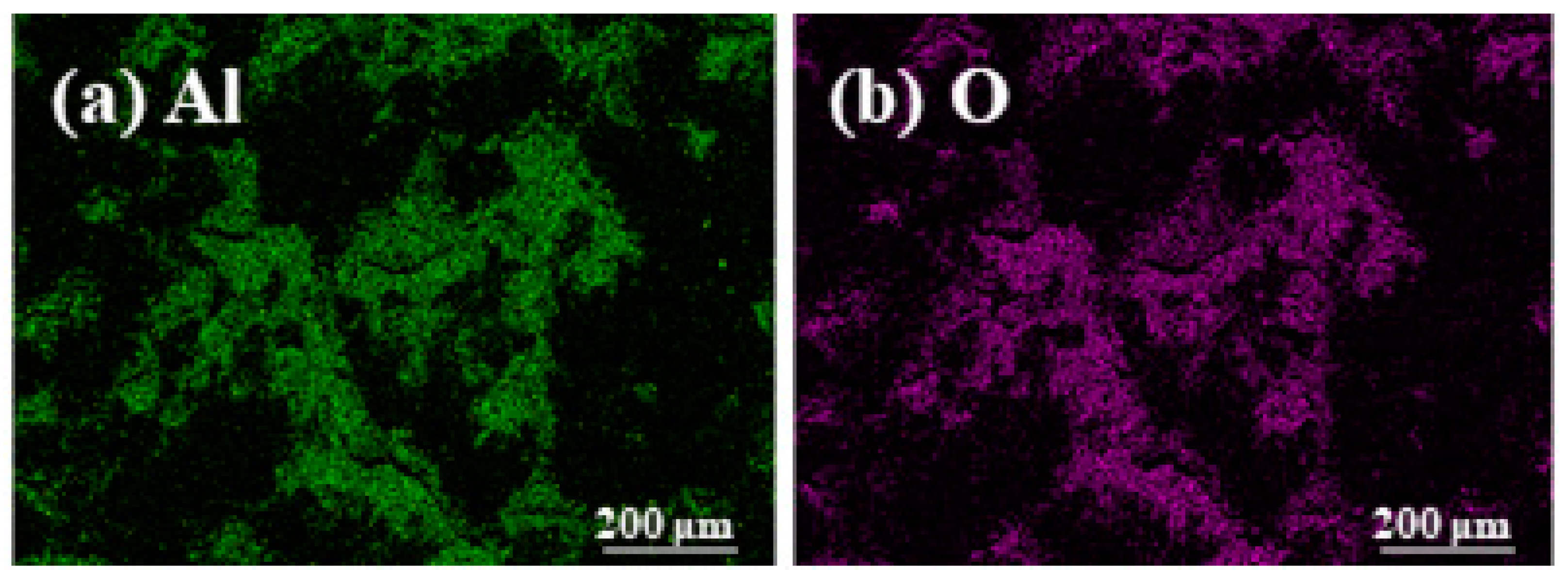
| Spray Parameters | Unit | ||
|---|---|---|---|
| Coating materials | 86WC–10Co–4Cr | Cr3C2–25NiCr | Al2O3–3TiO2 |
| Spray type | HVOF | APS | APS |
| Buffer layer | - | Ni–5Al | - |
| Voltage | 36 V | 60 V | 60 V |
| Current | 600 mA | 600 mA | 600 mA |
| Air pressure | 40 psi | 105 psi | 105 psi |
| Spray Distance | 8 inch | 9 inch | 9 inch |
| Gun spraying angle | 90 | 90 | 90 |
| Gun/feed/spray rate (g/min) | 25 | 80 | 80 |
| Thickness | 150 μm | 150 μm | 100 μm |
| Buffer layer | - | - | Ni-5Al (50 μm) |
Disclaimer/Publisher’s Note: The statements, opinions and data contained in all publications are solely those of the individual author(s) and contributor(s) and not of MDPI and/or the editor(s). MDPI and/or the editor(s) disclaim responsibility for any injury to people or property resulting from any ideas, methods, instructions or products referred to in the content. |
© 2024 by the authors. Licensee MDPI, Basel, Switzerland. This article is an open access article distributed under the terms and conditions of the Creative Commons Attribution (CC BY) license (https://creativecommons.org/licenses/by/4.0/).
Share and Cite
Bang, J.; Lee, E. Enhancing Wear Resistance of A390 Aluminum Alloy: A Comprehensive Evaluation of Thermal Sprayed WC, CrC, and Al2O3 Coatings. Coatings 2024, 14, 853. https://doi.org/10.3390/coatings14070853
Bang J, Lee E. Enhancing Wear Resistance of A390 Aluminum Alloy: A Comprehensive Evaluation of Thermal Sprayed WC, CrC, and Al2O3 Coatings. Coatings. 2024; 14(7):853. https://doi.org/10.3390/coatings14070853
Chicago/Turabian StyleBang, Jaehui, and Eunkyung Lee. 2024. "Enhancing Wear Resistance of A390 Aluminum Alloy: A Comprehensive Evaluation of Thermal Sprayed WC, CrC, and Al2O3 Coatings" Coatings 14, no. 7: 853. https://doi.org/10.3390/coatings14070853






